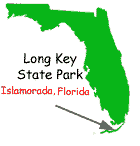

Management & Protection
Florida State Parks are managed as natural systems. All plant and animal life is protected in state parks. Hunting, livestock grazing and timber removal are not permitted. Do not remove, deface, mutilate or molest any natural
resources. For your safety, do not feed any animals. Intoxicants and firearms are prohibited.
Hours of Operation
Florida state parks are open from 8 a.m. until sundown 365 days a year.
|
|


|

Reservations for
Florida State
Parks are now
made through
Reserve America,
toll free, at
1-800-326-3521
|
LONG
KEY STATE PARK
Long Key was once referred to by the Spanish as "Cayo
Vivora", which means Rattlesnake Key. The name was used to describe
the shape of the island, which resembles a snake with its jaws open. Today,
Long Key State Park is known for being rich in history and recreational
opportunities as well as natural beauty.
The 965 acres that make up Long Key were acquired between 1961 and 1973,
with the park's official opening in 1969.
HISTORY
Long before the park was established, the subtropical climate, clear waters
and abundance of marine life attracted explorers. The Calusa Indians lived
off the plant and marine life before the arrival of the first Spanish settlers.
After Spanish occupation, other travelers from nearby islands such as the
Bahamas made their way to Long Key.
By 1912, the Florida Keys were no longer considered a remote area to
travel. By this time, the Key West Extension of the Florida East Coast
Railroad was completed, allowing Long Key to become an important depot.
Henry Flagler, the founder of the railroad, also established the Long
Key Fishing Club which was a mecca for the world's greatest saltwater
fishermen. This productive era came to a temporary end when a hurricane
destroyed the railroad and fishing club in 1935.
GEOGRAPHY & WILDLIFE
Long Key contains the remains of ancient coral reefs that were formed
100,000 years ago when the sea level was 20 to 30 feet higher. The vegetation
is primarily of West Indian or Caribbean origin. A large variety of trees
and shrubs are found, including species such as the gumbo limbo, poisonwood,
mahogany, Jamaica dogwood and crabwood. The shallow waters off Long Key
support an abundance of marine life. Various wading bird species may be
observed in the mangrove-lined lagoons, particularly during the winter months.
ACTIVITIES
Educational offerings at the park include fun and informative programs on
snorkeling, fishing, birding, canoeing, sea turtles, plants, history and
the marine ecology of the area.

Long Key State Recreation Area is located at Mile Marker 67.5, 67400 Overseas Highway in the Florida Keys
For more information:
Long Key State Park
P.O. Box 776
Long Key, FL 33001
(305) 664-4815
View Larger Map |
|
|



![]()

